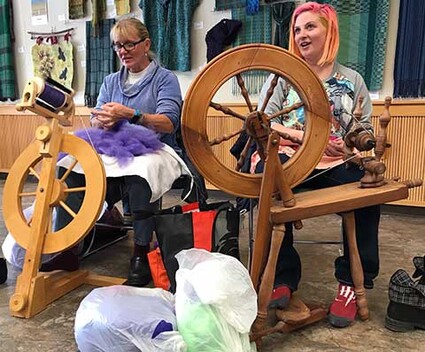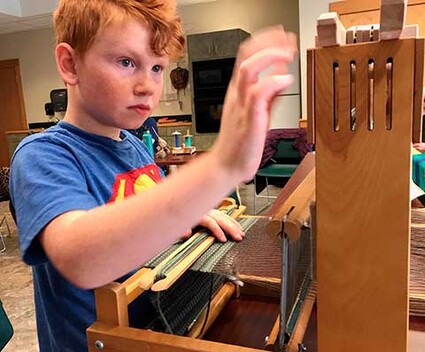Spinning, weaving grow in popularity
Last updated 10/15/2019 at Noon

Helen Schmidling
Carol Bunker and her daughter, Colleen Franks, spin alpaca yarn during the demonstration at the Sisters Library. w
Eight-year-old Nolan Riding ran the shuttle back and forth across the weft of fiber on his table loom, and then pressed the beater against the weave, creating a pattern of fabric that will be a table runner. Nolan and his six-year-old brother John are the youngest members of the Central Oregon Spinners and Weavers Guild. They understand the mechanics and the process of weaving, and both have created finished items.
The young brothers got involved in weaving after a visit to their grandfather’s neighbor intrigued them. The neighbor had a loom, and the boys wanted to know how it worked.
“So I encouraged them,” said their mom, Courtney. “We are a family of redheads — we can’t go out much in the summer, so I’m always looking for things to keep the kids busy indoors.”
Both entered items in the Deschutes County Fair this summer, and Nolan took home a blue ribbon and a best of show.
At the Sisters Library on Saturday, Nolan set up his table loom and easily described the process that he’s been working on for more than a year now. Both Nolan and John have items on display as part of the Guild’s annual show in the Library’s Community Room. Around the tables on Saturday, other Guild members demonstrated different kinds of weaving and spinning techniques.
The Guild has its own loom set up as a demonstration of weaving twill fabric in different patterns. Stephanie Stanley, past president of the group, explained the process, which can yield fairly complex designs, or fabric as simple as the denim in your jeans.
“Plain weave is over and under and over — twill is a variation on that,” she said.
Kathleen Tovey of Tumalo demonstrated spinning on a wheel, turning a blend of unspun wool and mohair into yarn that she will use to weave. As the bobbin turned, it created a sparkling rainbow effect.
Donna and Jim Wilson used Turkish drop (also known as cross-arm) spindles that turn unspun fibers into balls of wool or wool-blend with a neat center pull thread. Turkish drop spinning is one of the oldest forms of creating a single yarn from a pile of “fluff” and it does not require a complex wheel. Jim makes their spindles, which consist of a pair of small wooden arms that cross and a tapered shaft inserted down the center.
Carol Bunker and her daughter, Colleen Franks, popped into the room partway through the demonstration period. They quickly set up side-by-side spinning wheels, pulled out their fluffy bags of unspun alpaca, and started to work.
“My mom moved here from Anchorage and adopted some alpacas,” Colleen said. “Before she knew it, those cute fluffy animals yielded a huge pile of fluff and she wanted to know what to do with it.”
“I came here for better weather,” Carol said, “but I still go back several times a year because I have a business there.”
Colleen followed her mom from Alaska to Oregon, and recently got married.
They brought bags of roving, which is unspun fiber, as colorful as Carol’s shocking pink and yellow hair. Carol pulled apart a huge bag of hand-dyed purple, while Colleen’s stash was bright pink. Within a few minutes, both wheels were flying and the piles of pink and purple alpaca became soft vibrant yarns, ready to
weave.
“We’re all about animals, and looms, and spinning wheels,” Stephanie Stanley explained.
Many of the Guild members raise and shear their own sheep and alpacas, and others prefer to work with plant fibers.
Guild meetings are held on the third Wednesday of each month at 9:30 a.m. in the Highland Baptist Church in Redmond, and in Sisters City Hall on the fourth Saturday of each month at 1 p.m. Anyone with an interest in the creation of fine natural fiber art from animals or plants is welcome to join. In recent years, the membership has grown from about 30 to more than 120 today.
There is a program at each meeting, and people bring their current work to show. The next meeting’s program will be on the different breeds of sheep. The topic is “Shave ’Em to Save ’Em: Exploring Different Heritage Breeds in Central Oregon.” The focus is specifically on breeds most suited to this area; the following month, breeds from other parts of Oregon will be discussed.
“Sheep were bred throughout the ages for different uses of their wool — some for carpets, others for heavy coats, and still others for soft sweaters,” Stanley said. “There are certain things you can do when spinning that make a yarn softer or harder, but the most determining factor is actually the breed,” she explained.
The display in the library includes wearable art in the form of ponchos, vests, wraps, and scarves in solids, patterns and plaids. There are also rugs, wall hangings, and linen dishtowels which last through generations. Some of the items are for sale, and there are forms available to fill out if you wish to purchase. The Spinners and Weavers Guild show is up through October 30.
The Guild’s next event will be the 2019 Holiday Show and Sale, Friday, November 1 from 5 to 9 p.m. and Saturday, November 2 from 10 a.m. to 4 p.m. at the Environmental Center, 16 NW Kansas Ave. in Bend. See how fabric is woven and yarn is spun while shopping for locally handcrafted goods. The Guild’s website is currently being reconstructed, but more information on joining is available from Stephanie Stanley, 541-678-5449.

















Reader Comments(0)